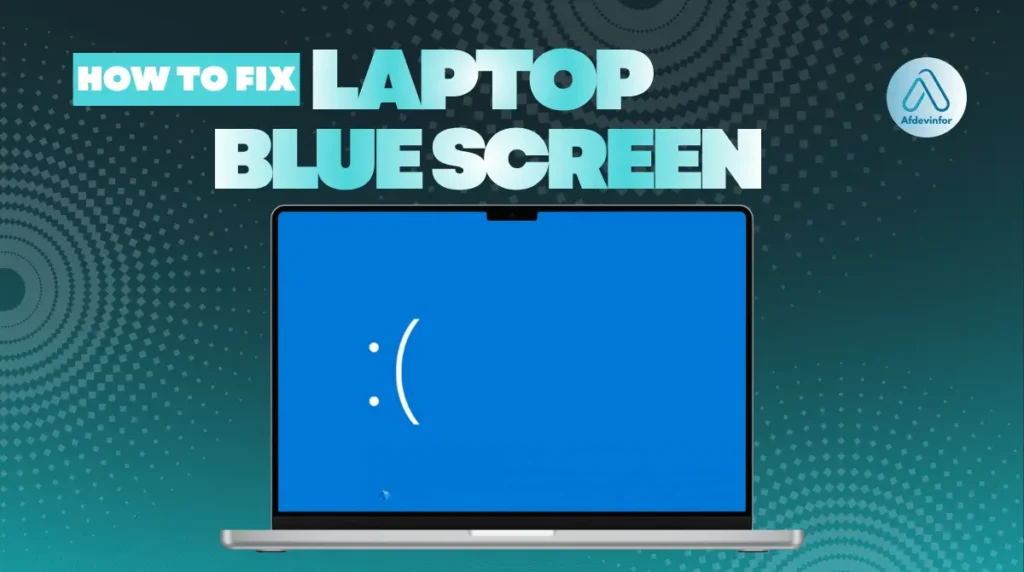As a tech expert with years of experience, I know that a few things cause more panic than seeing a blue screen. Today, I’m going to show you exactly how to fix blue screen on laptop.
That sudden, jarring crash – often called the ‘Blue Screen of Death’ or BSOD – immediately makes you worry about your important files and the health of your machine. But don’t panic. I’ve guided countless users through this exact problem, and I’m here to walk you through it with a safety-first approach. We’ll secure your data before we even think about a fix.
1. Securing your data before you troubleshoot
Before you dive into any technical fixes, we need to address the most important question on your mind: ‘Is my data safe after a BSOD crash?’ The crash itself usually doesn’t delete your files, but the underlying cause might.
That’s why my first and most critical piece of advice is to focus on your data. This is our ‘SAFETY-FIRST‘ approach, and it’s the single most important step you can take to recover from a blue screen with peace of mind.
DO NOT attempt complex fixes until you’ve tried to back up your data.
1.1. How to back up files if you can still access windows (even briefly)
If your laptop restarts and lets you into Windows, even for a few minutes before crashing again, you have a golden opportunity to save your files. You need to act fast. Here is a quick protocol to follow:
- Plug in an external storage device. This can be a USB flash drive or an external hard drive with enough free space.
- Open File Explorer. You can do this by pressing the Windows key + E.
- Navigate to your user folder. This is usually located at `C:\Users\[Your Username]`.
- Prioritize essential folders. Drag and drop the following folders from your user profile to your external drive: Desktop, Documents, Downloads, Pictures, and Music.
- Eject safely. Once the copy is complete, right-click the external drive icon in the taskbar and select ‘Eject’ before unplugging it.
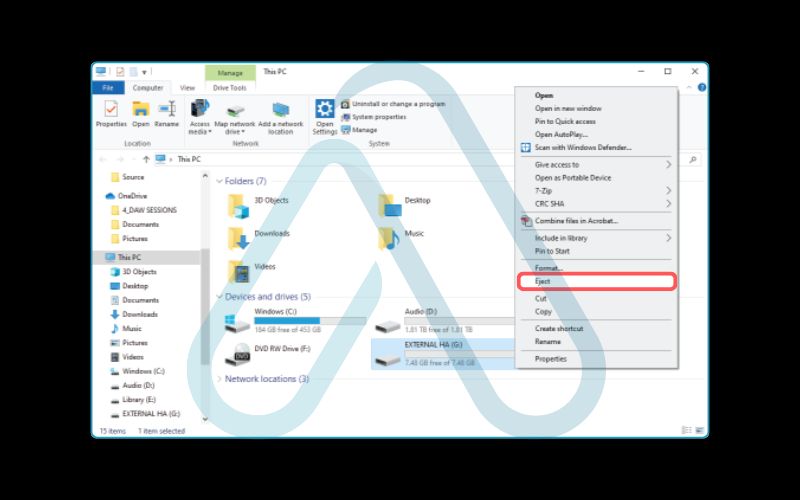
1.2. What to do if you can’t get into Windows with safe mode backup
If Windows won’t load at all, don’t despair. Our next step is to try booting into Safe Mode. Think of Safe Mode as a basic, stripped-down version of Windows that only loads the essential files and drivers needed to run. It’s designed specifically for troubleshooting situations like this.
Don’t worry, Safe Mode looks different and might have a low resolution, but all your files are still there. Here’s how to get there and perform a backup:
- Force the recovery environment. Turn your laptop on. As soon as you see the manufacturer’s logo, press and hold the Power button until it shuts down. Repeat this process 2-3 times. This will signal to Windows that something is wrong, and it should load the ‘Advanced startup’ options screen.
- Navigate to Safe Mode. On the blue ‘Choose an option’ screen, select Troubleshoot > Advanced options > Startup Settings > Restart.
- Select Safe Mode. After your laptop restarts, you will see a list of options. Press the F5 key or the 5 key to select ‘Enable Safe Mode with Networking’. The networking option is useful if you want to back up to a cloud service like Google Drive or Dropbox.
- Back up your files. Once in Safe Mode, your desktop will look different, but you can open File Explorer and follow the exact same steps outlined in section 1.1 to copy your files to an external drive.
2. What is the ‘blue screen of death’ and what causes it?
Now that your data is hopefully safe, let’s demystify that scary blue screen. The Blue Screen of Death (BSOD) isn’t just a crash; it’s a protective measure. I like to think of it as a fire alarm for your computer. The blue screen is your laptop’s way of shouting, ‘Stop! Something is seriously wrong, and I’m shutting down to protect myself from potential hardware damage’.
Understanding what causes blue screen errors on laptops is the first step to fixing them. The causes generally fall into two categories: software and hardware. Here are some of the most common culprits I’ve seen over the years:
Software Issues: This is the most frequent cause and often the easiest to fix.
- Corrupt or outdated device drivers
- Malware or viruses
- Corrupted system files
- Problems with a recent Windows update or software installation
Hardware Issues: These can be more serious but are less common.
- Failing RAM (memory)
- Overheating components (CPU or GPU)
- A failing hard drive (HDD) or solid-state drive (SSD)
- Newly installed, incompatible hardware
3. Decoding the blue screen and how to find your error code
The blue screen itself contains the most valuable clue to solving the problem: the error code, also known as the ‘Stop Code’. Instead of just restarting in a panic, take a moment to look at the screen.
Modern Windows 10 and 11 blue screens are much more helpful than older versions. You’ll see a sad face emoji, a QR code you can scan with your phone, and most importantly, a line of text near the bottom that says ‘Stop Code’. That Windows stop code error is your key. Write it down or take a picture of it with your phone.
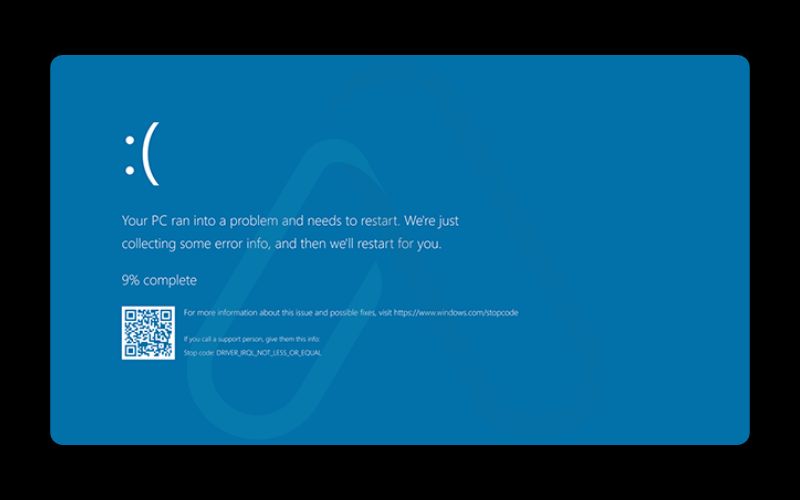
To help you get started, I’ve created a lookup table of some of the most common stop codes I encounter:
| Stop Code | What It Usually Means | Recommended First Fix |
|---|---|---|
CRITICAL_PROCESS_DIED | A critical Windows process has failed. This is often due to file corruption or a driver issue. | Run a system file check (SFC) scan. If that fails, try a System Restore. |
SYSTEM_SERVICE_EXCEPTION | A common error often caused by outdated or corrupt drivers, especially graphics drivers. | Update your graphics driver. See section 4.4 for instructions. |
IRQL_NOT_LESS_OR_EQUAL | This technical-sounding error usually points to a faulty driver or a problem with your laptop’s memory (RAM). | Update key drivers. If it persists, test your RAM using the steps in section 5.1. |
INACCESSIBLE_BOOT_DEVICE | Windows lost access to the system partition during startup. This could be a driver issue or a failing hard drive. | Check hard drive connections (if possible) and test the drive using the steps in section 5.2. |
MEMORY_MANAGEMENT | This error strongly indicates a problem with your system’s RAM. | Run the Windows Memory Diagnostic tool immediately (section 5.1). |
4. Step-by-step software fixes to solve the blue screen error
With our data safe and a potential error code in hand, it’s time to troubleshoot BSOD issues methodically. We’ll approach this as a process of elimination, starting with the simplest and least invasive solutions. My advice is to try each step, restart your computer, and see if the problem is resolved. If one doesn’t work, just move on to the next. This section will guide you on how to fix blue screen on laptop issues caused by software.
4.1. Undo recent changes
The most logical starting point is to ask, ‘What changed recently?’ If your laptop was working fine yesterday but is crashing today, a recent change is the likely culprit. Let’s undo those changes.
- Unplug all non-essential peripherals. Disconnect any external webcams, printers, USB hubs, or drives. A faulty device or its driver can cause instability. Reboot and see if the error is gone.
- Uninstall recently added programs. Did you install a new game, antivirus, or other software right before the crashes started? Go to ‘Settings’ > ‘Apps’ > ‘Apps & features’ and uninstall it. Reboot your laptop.
- Roll back recent updates. Sometimes a Windows update can cause conflicts. Go to ‘Settings’ > ‘Update & Security’ > ‘Windows Update’ > ‘View update history’ > ‘Uninstall updates’ and remove the most recent one. Reboot afterward.
4.2. Use System Restore to go back in time
If simply uninstalling a program didn’t work, System Restore is our next powerful tool. I often describe it as a ‘time machine’ for your laptop’s critical system files. It allows you to revert your system’s configuration to an earlier point in time (a ‘restore point’) without affecting your personal files like documents, photos, or emails. This is a fantastic way to use System Restore in Windows to fix problems caused by a bad installation or driver update.
You can access System Restore from within Windows by searching for ‘Create a restore point’ in the Start Menu and clicking the ‘System Restore…’ button. If you can’t get into Windows, you can access it from the same ‘Advanced options’ menu we used in section 1.2.
4.3. Scan for malware and viruses
Malicious software can dig deep into the operating system and cause all sorts of instability, including blue screens. While a standard scan is good, I recommend running a more thorough offline scan, as it can detect malware that might hide itself when Windows is running normally.
Here’s how to do it with the built-in Microsoft Defender:
1. Open Windows Security from your Start Menu.
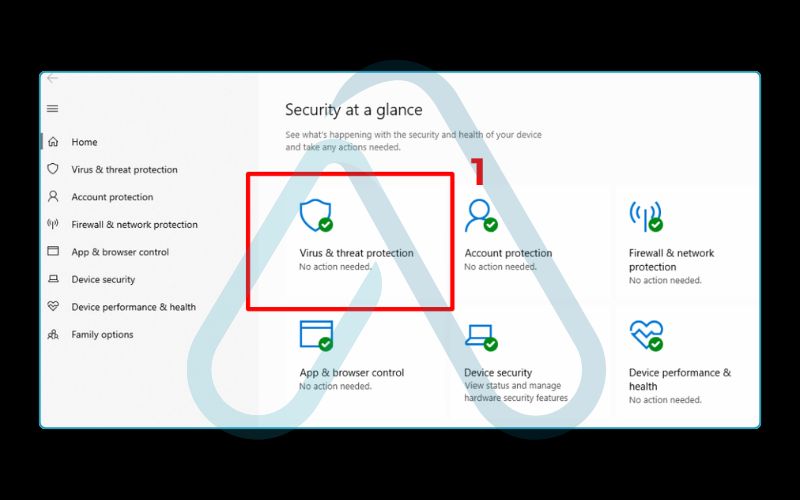
2. Go to Virus & threat protection.
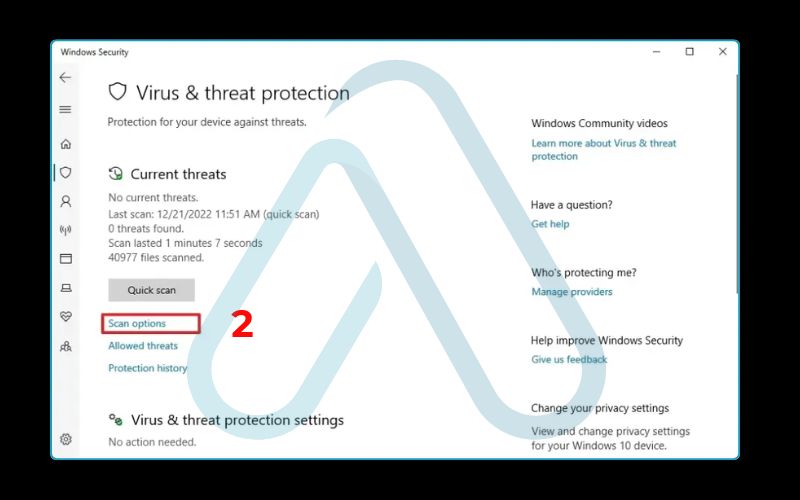
3. Click on Scan options.
4. Select Microsoft Defender Offline scan and then click Scan now.
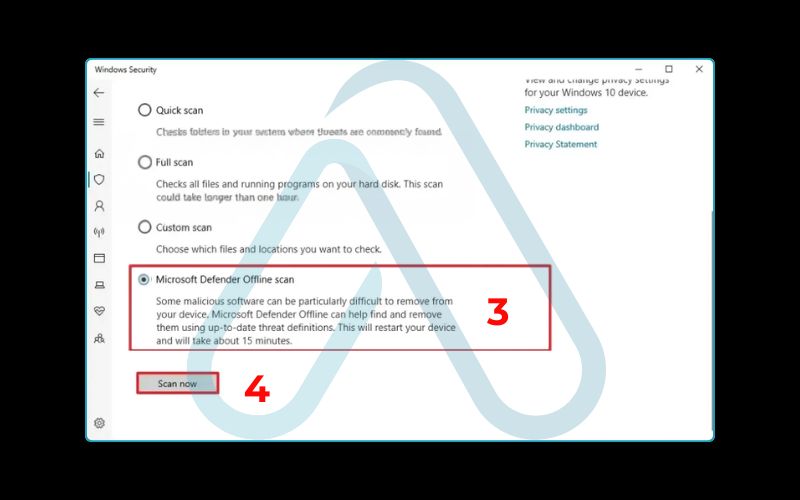
Your laptop will restart and perform a deep scan before Windows loads. This process can take about 15-20 minutes.
4.4. Update your system and device drivers
Outdated, corrupt, or incorrect device drivers are one of the most common causes of BSODs I’ve ever dealt with. A driver is a small piece of software that lets Windows communicate with a piece of hardware, like your graphics card or Wi-Fi adapter. When that communication breaks down, the system crashes.
First, run Windows Update (‘Settings’ > ‘Update & Security’) to get all the latest system patches. Then, check your key drivers, prioritizing the graphics card driver as it is a frequent culprit.
You can do this through the Device Manager. Right-click the Start button and select ‘Device Manager’. Find the component (e.g., ‘Display adapters’), right-click it, and select ‘Update driver’.
5. Investigating hardware issues when software isn’t the problem
If you’ve tried all the software fixes and the blue screen persists, it’s time to consider the possibility of BSOD hardware issues. This directly answers the common question, ‘Can a blue screen be caused by hardware problems?’
Yes, absolutely. A failing component inside your laptop can certainly cause these crashes. We’re going to use some built-in tools to diagnose the most common hardware culprits without needing to open your machine.
| Caution: Do not open your laptop if it is under warranty, as this may void it. Use these software-based diagnostic tools instead. |
5.1. Checking your laptop’s memory (RAM)
RAM, or Random Access Memory, is your laptop’s short-term memory. It’s where active programs and data are stored for quick access. If a RAM stick is faulty, it can corrupt data as it’s being processed, leading to system instability and crashes. Windows has a built-in tool to test it.
- Press the Windows key + R, type `mdsched.exe` into the Run box, and press Enter.
- You’ll be prompted to restart your computer. Choose ‘Restart now and check for problems’.
- Your laptop will restart and begin the memory test. This can take some time, so be patient.
- Once it’s complete, Windows will restart, and the results will be displayed after you log in. If it reports any errors, you’ve likely found your problem: a faulty RAM stick that needs replacing.
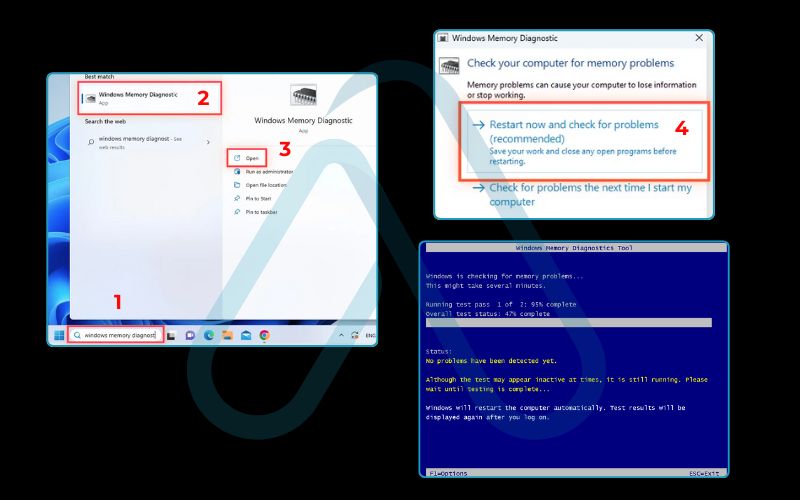
5.2. Testing your hard drive or SSD
Your hard drive or Solid State Drive (SSD) is where Windows and all your files are permanently stored. If this drive starts to fail, it can corrupt system files, leading to a BSOD. We can use a command-line utility called ‘Check Disk’ to scan the drive for errors.
- Open the Start Menu, type `cmd`, right-click on ‘Command Prompt’, and select ‘Run as administrator’.
- In the black window that appears, type the following command and press Enter:
chkdsk /f /rYou will likely be told that the volume is in use and asked if you want to schedule the scan for the next restart. Type Y and press Enter. Now, restart your laptop. The scan will begin before Windows loads.
Be warned, this can take a very long time, sometimes several hours, so do this when you don’t need your laptop for a while.
6. The critical decision: When to get professional help
Doing it yourself is rewarding, but knowing when to call an expert is smart. If you’ve reached this point and are still seeing blue screens, it’s time to decide on the next step. So, when should I contact professional support for a blue screen?
Let’s make that decision easier for you with a simple logic tree. Use these points to guide your choice:
- IF the Windows Memory Diagnostic reported errors… THEN it’s time to see a professional about identifying and replacing the faulty RAM stick.
- IF the `chkdsk` scan reported unfixable errors or the BSODs persist and mention a ‘BOOT DEVICE’… THEN your storage drive is likely failing and needs to be replaced by a technician.
- IF the blue screens happen mostly when you are gaming or doing intensive tasks… THEN your laptop could be overheating, and a professional cleaning of the fans and heatsink is in order.
- IF you have tried all the software steps and are not comfortable with hardware diagnostics… THEN it is perfectly fine to save yourself the time and stress and take it to a reputable repair shop.
7. Official support and driver portals for major laptop brands
When you’re dealing with driver issues, my strong recommendation is to get them directly from your laptop’s manufacturer. While Windows Update does a decent job, the official drivers are specifically tailored to your machine’s hardware and are often more stable. This is a valuable resource that can save you a lot of trouble.
Here is a list of direct links to the support pages for major laptop brands where you can find drivers, diagnostic tools, and warranty information.
| Brand Name | Support/Driver Link | Warranty Check Link |
|---|---|---|
| Dell | dell.com/support | dell.com/support/warranty |
| HP | support.hp.com | support.hp.com/checkwarranty |
| Lenovo | pcsupport.lenovo.com | pcsupport.lenovo.com/warrantylookup |
| Asus | asus.com/support/download-center | asus.com/support/warranty-status-inquiry |
| Microsoft Surface | support.microsoft.com/surface | account.microsoft.com/devices |
| Acer | acer.com/support | acer.com/support/warranty-information |
8. FAQs about how to fix blue screen on laptop
Will a blue screen error delete my files?
No. The crash itself does not delete your files, but if the cause is a failing hard drive, it can lead to data loss. Always back up your important files before troubleshooting.
How can I prevent blue screen errors in the future?
Keep Windows and drivers updated, avoid untrusted software, ensure proper cooling, and run malware scans regularly. These steps greatly reduce the risk of BSODs.
Is a recurring blue screen a sign that I need a new laptop?
Not necessarily. It usually points to a hardware or software issue that can often be repaired, such as bad RAM or driver conflicts. Try repairs first before replacing your device.
Glossary of key terms
Here is a quick reference for some of the technical terms I used in this article.
| Abbreviation | Full Term | Meaning |
|---|---|---|
| BSOD | Blue Screen of Death | A critical error screen displayed by Windows when it encounters a problem it cannot recover from. |
| RAM | Random Access Memory | The computer’s short-term memory, used to store data for active applications. |
| SSD | Solid State Drive | A type of storage drive that uses flash memory, which is much faster than a traditional hard drive. |
| Driver | Device Driver | Software that allows the Windows operating system to communicate with and control a piece of hardware. |
| Stop Code | (N/A) | The specific error code displayed on a BSOD screen that helps identify the problem. |
| chkdsk | Check Disk | A Windows command-line utility used to check a storage drive for file system errors and bad sectors. |
| Safe Mode | (N/A) | A diagnostic mode of Windows that loads a minimal set of drivers and files to help troubleshoot problems. |
9. Final thoughts
Facing a blue screen is stressful, but as I’ve shown you, it’s a problem you can often solve yourself with a methodical approach. By shifting your initial focus from ‘fixing the crash’ to ‘securing my data,’ you move from a position of panic to one of control. From there, it’s a logical process of elimination through software and hardware diagnostics.
Here are the most critical takeaways from my guide:
- Data First, Always: Before any other step, do everything you can to back up your important files, using Safe Mode if necessary.
- Read the Clues: The blue screen itself gives you a valuable clue in the form of a ‘Stop Code’. Use it to narrow down the potential cause.
- Troubleshoot Methodically: Start with simple software fixes like undoing recent changes and move progressively to more complex hardware diagnostics.
- Know When to Get Help: There is no shame in seeking professional help, especially when hardware tests indicate a failing component. It’s the smart choice.
You are now equipped with the knowledge to tackle one of the most common and feared computer problems. By following these steps, you can confidently troubleshoot your laptop and get it back up and running. For more in-depth guides on keeping your digital life secure and optimized, I invite you to explore our Productivity & Automation categories on Afdevinfo.


